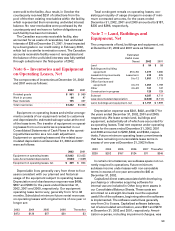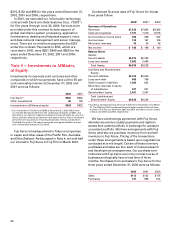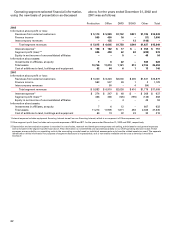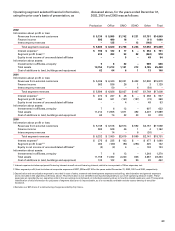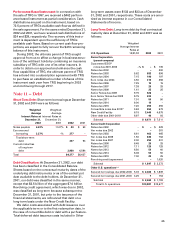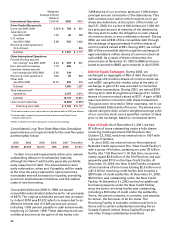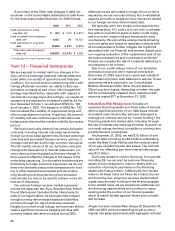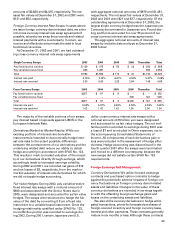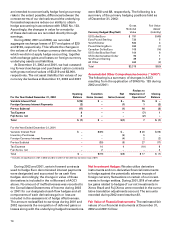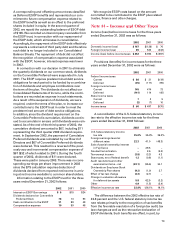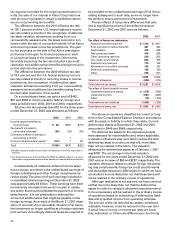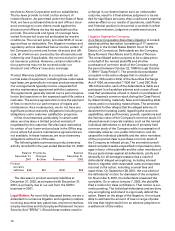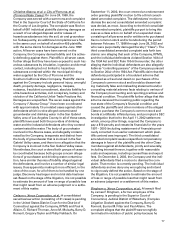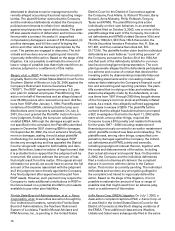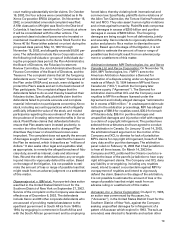Xerox 2002 Annual Report Download - page 71
Download and view the complete annual report
Please find page 71 of the 2002 Xerox annual report below. You can navigate through the pages in the report by either clicking on the pages listed below, or by using the keyword search tool below to find specific information within the annual report.
69
amounts of $3,820 and $4,415, respectively. The net
asset fair values at December 31, 2002 and 2001 were
$121 and $52, respectively.
Foreign Currency Interest Rate Swaps: In cases where
we issue foreign currency-denominated debt, we enter
into cross-currency interest rate swap agreements if
possible, whereby we swap the proceeds and related
interest payments with a counterparty. In return, we
receive and effectively denominate the debt in local
functional currencies.
At December 31, 2002 and 2001, we had outstand-
ing cross-currency interest rate swap agreements
with aggregate notional amounts of $879 and $1,481,
respectively. The net asset fair values at December 31,
2002 and 2001 were $21 and $17, respectively. Of the
outstanding agreements at December 31, 2002, the
largest single currency hedged was the Japanese yen.
Contracts denominated in Japanese yen, Pound ster-
ling and Euros accounted for over 95 percent of our
cross-currency interest rate swap agreements.
The aggregate notional amounts of interest rate
swaps by maturity date and type at December 31,
2002 follow:
Single Currency Swaps 2003 2004 2005 2006 Thereafter Total
Pay fixed/receive variable $ 139 $ 275 $ 172 $ 22 $ 250 $ 858
Pay variable/receive fixed 825 1,287 – – 850 2,962
Total $ 964 $1,562 $ 172 $ 22 $1,100 $3,820
Interest rate paid 0.79% 3.19% 6.61% 6.02% 5.37% 3.38%
Interest rate received 2.30 5.00 2.23 2.84 7.45 4.89
Cross Currency Swaps 2003 2004 2005 2006 Thereafter Total
Pay fixed/receive variable $257 $ 87 $ 8 $ – $ – $ 352
Pay variable/receive fixed – – – 406 122 528
Total $257 $ 87 $ 8 $ 406 $ 122 $ 880
Interest rate paid 5.02% 5.97% 6.85% 2.53% 2.93% 3.69%
Interest rate received 1.42 1.42 1.42 1.50 2.00 1.54
The majority of the variable portions of our swaps
pay interest based on spreads against LIBOR or the
European Interbank Rate.
Derivatives Marked-to-Market Results: While our
existing portfolio of interest rate derivative
instruments is intended to economically hedge inter-
est rate risks to the extent possible, differences
between the contract terms of our derivatives and the
underlying related debt reduce our ability to obtain
hedge accounting in accordance with SFAS No. 133.
This results in mark-to-market valuation of the majori-
ty of our derivatives directly through earnings, which
accordingly leads to increased earnings volatility.
During 2002 and 2001, we recorded net gains of $12
and net losses of $2, respectively, from the mark-to-
market valuation of interest rate derivatives for which
we did not apply hedge accounting.
Fair Value Hedges: During 2002, pay variable/receive
fixed interest rate swaps with a notional amount of
$600 and associated with the Senior Notes due in
2009, were designated and accounted for as fair value
hedges. The swaps were structured to hedge the fair
value of the debt by converting it from a fixed rate
instrument to a variable based instrument. Since the
hedging relationship qualified under SFAS No. 133,
no ineffective portion was recorded to earnings dur-
ing 2002. During 2001, certain Japanese yen/U.S.
dollar cross-currency interest rate swaps with a
notional amount of 65 billion yen were designated
and accounted for as fair value hedges. The net inef-
fective portion recorded to earnings during 2001 was
a loss of $7 and is included in Other expenses, net in
the accompanying Consolidated Statements of
Income. All components of each derivatives gain or
loss were included in the assessment of hedge effec-
tiveness. Hedge accounting was discontinued in the
fourth quarter 2001 after the swaps were terminated
and moved to a different counterparty, because the
new swaps did not satisfy certain SFAS No. 133
requirements.
Foreign Exchange Risk Management:
Currency Derivatives: We utilize forward exchange
contracts and purchased option contracts to hedge
against the potentially adverse impacts of foreign cur-
rency fluctuations on foreign currency denominated
assets and liabilities. Changes in the value of these
currency derivatives are recorded in earnings togeth-
er with the offsetting foreign exchange gains and
losses on the underlying assets and liabilities.
We also utilize currency derivatives to hedge antici-
pated transactions, primarily forecasted purchases of
foreign-sourced inventory and foreign currency lease,
interest and other payments. These contracts generally
mature in six months or less. Although these contracts


